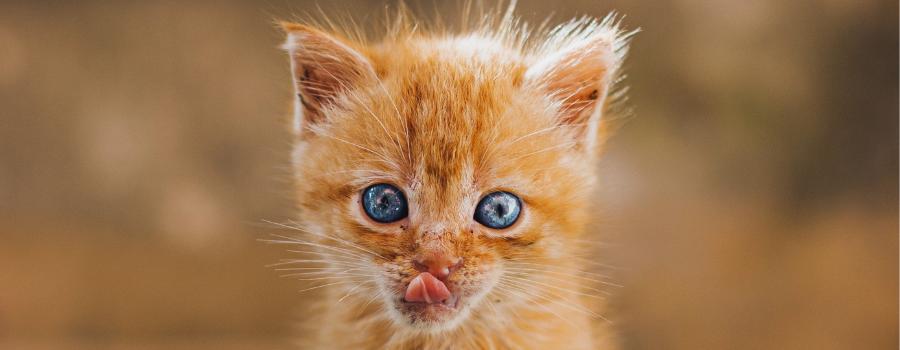The life of every cat lover is studded with encounters with more or less docile or rebellious specimens and, sometimes, these encounters turn - out of necessity, for example to put a stray kitten in safety - into an attempt of approach that may not be so simple.
Because taming a cat - in the sense of convincing it to trust the human and get closer to it - is not always a walk in the park, especially when the feline was born and raised in the wild. However, even domestic cats, born in a domestic environment, although less suspicious and easier to domesticate, can be unruly and rebellious. Therefore, it is necessary to know how to educate a cat, that is to say to be able to communicate effectively its disappointment every time it does something naughty, and then to be able to reinforce its positive behavior.
Approach a stray and distrustful cat: getting to know it
But if it is much easier to approach a domestic cat, how can you approach a suspicious cat that does not know you?Stray cats are suspicious, they look at you curiously but keep their distance. The only way to approach a wary cat is to arm yourself with a lot of patience and start by letting it get to know you. Let it become familiar with your presence, see you come and go without doing anything in particular. And while you establish this first eye contact, remember to talk to him: always talk to him, use sweet and persuasive tones, reassure him, and let him learn to recognize your voice. Litle by little he will understand that you do not pose a threat.
Don't be in a hurry
There are stray cats that get close to humans in a short time, because they quickly learn to trust, or because they are of a particularly sociable disposition. Taming such a cat will certainly be easier, because it is possible that it will get used more willingly than others to domestic life and the presence of humans. On the other hand there are stray cats that take months, if not even years, before letting themselves be touched by those who with love and constancy feed them and take care of them. The tactic is always the same: food, patience and perseverance. And no forcing.
Some strays never become true house cats, but it is very likely that despite their extremely independent nature, even the most die-hard ones end up appreciating the domestic garden and cuddles "at a distance", so to speak, because good food and a quiet place to take a nap are not things to throw away! A stray like this will not be easy to tame, but can be conquered slowly with respect for his free and independent nature. Then who knows, maybe one day he might finally want to take a walk inside the house, just to have a look around. And if it is true that one thing leads to another....
If the cat is afraid
There is also the possibility that you have to deal with a frightened cat, and also in this case the challenge is to win its trust by overcoming its mistrust, trying to understand the reason for its fear. It could be a lost house cat, so consider that it is certainly not used to its environment and is disoriented: it is not a good idea to try to approach it, as you could make it run away and put it in danger, but it is necessary to entice it to come closer using food.Even a recently adopted cat can be frightened as soon as he arrives at home, and it is up to you to win him over with rewards, sweet words and reassurance. If he hides, don't force him to come out of his hiding place, respect his time and leave him alone, he will come out when he feels calmer. If he blows at you, don't try to approach him: give him food and water, a litter box for his needs, create a kennel for him in a quiet and safe place, then ignore him and give him time to calm down and acclimatize.
Remember that at the end of the day he must get used to a completely new situation: slowly he will overcome his curiosity and decide to explore the house, let him do so without interfering. Sooner or later he will want to give you a sniff too, and maybe he will even let you give him a little scratch behind the ear.
In all cases, when it comes to taming a cat, the rule of patience applies: you must not be in a hurry or, in all probability, you will fail.
The irresistible temptation of the bowl
However, remember that you can always play the ultimate card, the wild card that will most likely give you success, which is food. Because - let's face it - what is the cat that can resist without batting an eyelid an inviting and delicious recipe? Probably no one. For this reason, when it is time to tame a cat it is advisable not to forget to offer it food: an irresistible meal, especially for its very sensitive sense of smell, will help you to win first of all its attention and then its trust. For example, you could try to tempt him with a refined surprise enclosed in a soft Mousse, or lure him with a generous dose of extra sauce with unmistakable flavors or, finally, tantalize his palate with a delicate broth made with natural ingredients.It will be the scent coming from the bowl (placed in a safe place halfway between you and him) that will tempt him to come closer. Next to the bowl of food, leave a bowl of fresh water.
You will see that as soon as you move a few steps away, he will approach the bowl to eat: you sit and stay there a few feet away while your new friend enjoys his delicious meal, and let your voice keep him company.
Repeat these simple actions day after day, gradually trying to shorten the distance between you and the bowls: he will continue to come closer to feed himself. And remember that you must never try to approach your cat unknowingly, for example while he is eating, because he may become frightened and react aggressively or run away, and take away the trust that you have earned with so much effort. You must leave it the choice and the freedom to approach you, when and if it wants to.










